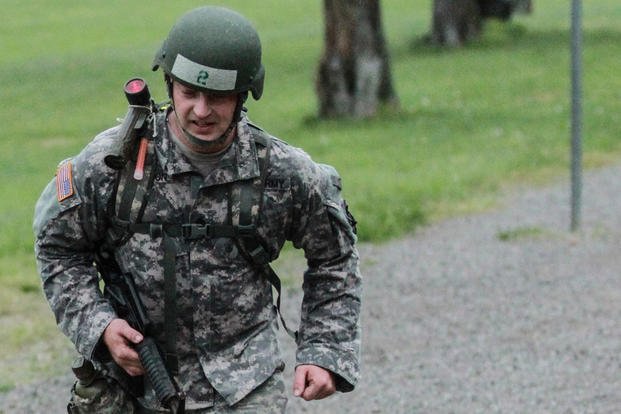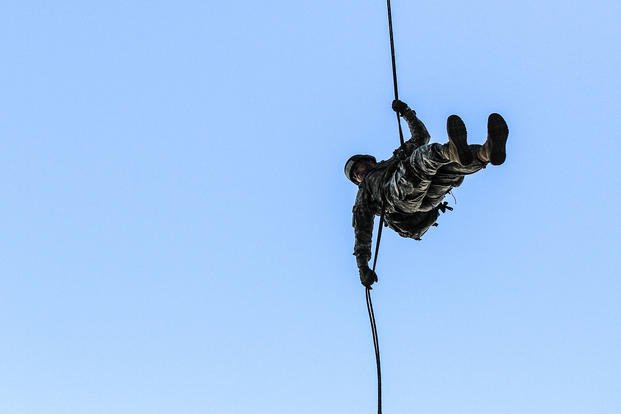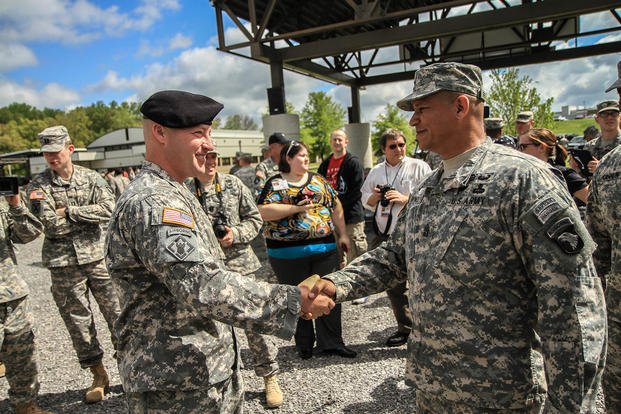FORT CAMPBELL, Ky. -- For almost 12 miles, he has been carrying about 35 pounds of gear. He sees a clock in the near distance with red, digital numerals closing in on the three-hour mark, the time limit for the near half-marathon march. He wants to sprint to the finish line, but his face winces with every right step taken. His breaths are heavy, and pain can be heard with each inhale.
His left leg is in full stride, but his right, being amputated more than six years ago, now pushes forward on a damaged prosthetic; a piston broke a few miles back eliminating fluid motion. He picks up a faster, but still limping, pace. Sweat drips into his eyes, and his fists are clenched tight as he approaches the finish line with two minutes to spare.
He stops before crossing, pulls out his canteen, pours water on his helmet and face. He takes a giant step with his left foot and says two words, "Air Assault." He then takes another step with his prosthetic, exhales and accomplishes his mission.

He has just completed the Army's Air Assault School -- on one leg.
Sgt. 1st Class Greg Robinson, a 34-year-old combat engineer assigned to the Company A, 2nd Brigade Special Troops Battalion, 2nd Brigade Combat Team, 101st Airborne Division (Air Assault), pinned on his Air Assault badge during a graduation ceremony at Fort Campbell's Sabalauski Air Assault School, April 29.
According to the school's records, Robinson is the first soldier with an amputated limb and prosthetic to complete the Air Assault School.
"It's a really good feeling, and I just hope this can inspire other amputees and other people with disabilities that they can accomplish things," said Robinson, who lost his lower right leg while deployed to Kandahar, Afghanistan, during a firefight in Operation Medusa, Oct. 3, 2006. "My biggest thing today is to let that someone who is laying there wounded in that hospital bed know not to get down on yourself. You can still continue despite missing a limb. A disability is only a disability if you let it hold you down."
The Army's Air Assault School is a 10-day course that qualifies soldiers to conduct air-assault helicopter operations, sling-load missions, fast roping and rappelling, and aircraft orientation that ends with a fast-paced, heavy-load, 12-mile ruck march. It is designed to push a service member's limits mentally and physically. It has been called the hardest 10 days in the Army.
"That was the toughest part, but it's over with now," Robinson said moments after completing the 12-miler. "I had problems with my leg during the Tough One, but fixed it and continued."

An air valve was knocked off during the school's obstacle portion of the course. During the 10 days, the school's staff ensured that a professional standard was maintained in regard to their grading of Robinson. There would be no bias for or against the amputee soldier.
"The instructors were a bit nervous when he first started, but they did their job just as if it were any other student, and on that note, I am very proud of them. They didn't see him as a disabled soldier and treated him just like anyone else coming to school to earn the Air Assault wings," said Sgt. 1st Class Matthew Connolly, a senior instructor at Sabalauski. "We are very proud of him, and I think others need to look at him as a mentor and an example of what you can accomplish when you set your mind on something."
Prior to attending the physically demanding school, Robinson needed a waiver from the unit's medical staff. Robinson's accomplishments continue to surprise and inspire those medics.
"Some of these guys never even learn to walk on a prosthesis, let alone go through the Air Assault course," said Capt. Gregory Gibson, the brigade nurse with the 101st's 2nd BCT, who worked with amputee soldiers at Walter Reed National Military Medical Center in Bethesda, Maryland, before coming to the Strike Brigade. "He's had this thing happen to him that most would see as a career ender; he's a shining example that life can carry on."
Robinson's momentum continues as he now looks to attend the school's master rappel course, which qualifies Air Assault school graduates in the skills and techniques necessary to rappel from moving aircraft. His wounded friends are still in his thoughts.
"When I was at Walter Reed, I looked around, felt sad for myself, but the more I looked, the more I realized there were so many who had it harder, who had it worse than me," Robinson said of his wounded warrior comrades. "A triple amputee, a quad-amputee -- and watching them work and push so hard inspired me."
Robinson slowly repeated an earlier phrase.
"A disability is only a disability if you let it hold you down."
Want to Know More About the Military?
Be sure to get the latest news about the U.S. military, as well as critical info about how to join and all the benefits of service. Subscribe to Military.com and receive customized updates delivered straight to your inbox.











